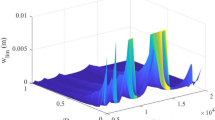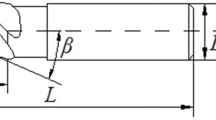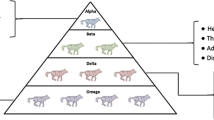Abstract
In the real machining environment of CNC milling, there are often multi-pass (rough milling and fine milling combined) and related to each other in the process. Aiming at the existing optimization model of processing parameters which is only limited to single-step machining process, an optimization method of processing parameters of multi-pass CNC milling towards energy and carbon emission efficiency was proposed. Firstly, the process and dynamic characteristics of energy consumption and carbon emission in multi-pass CNC milling are described comprehensively and systematically. Based on this, with the goal of optimizing energy efficiency, carbon emission efficiency and cost efficiency, and with the combination of process parameters under variable process conditions as variables, the optimization model of multi-pass milling process parameters was established. An improved non-dominated sorting gravitational search algorithm was used to optimize the solution, and the analytic hierarchy process (AHP) was used to determine the optimal solution from the Pareto frontier solution set that meets the specific application scenarios. At last, an experiment case is performed to verify the effectiveness and practicality of the optimization model.





Similar content being viewed by others
Data availability
All data calculated or analyzed during this research are included in this article.
References
Li C, Yu B, Xiao Z (2021) A Cutting Parameter Energy-saving Optimization Method for CNC Turning Batch Processing Considering Tool Wear. JME 57:217. https://doi.org/10.3901/JME.2021.01.217
Zhao G, Liu Z, He Y et al (2017) Energy consumption in machining: Classification, prediction, and reduction strategy. Energy 133:142–157. https://doi.org/10.1016/j.energy.2017.05.110
Gao K, Xu X, Jiao S (2022) Prediction and visualization analysis of drilling energy consumption based on mechanism and data hybrid drive. Energy 261:125227. https://doi.org/10.1016/j.energy.2022.125227
Triebe MJ, Zhao F, Sutherland JW (2021) Genetic Optimization for the Design of a Machine Tool Slide Table for Reduced Energy Consumption. J Manuf Sci Eng 143:101003. https://doi.org/10.1115/1.4050551
Jun X, Fei L, Wei C (2019) Research on the Characteristics and Methodology for Predicting Energy Efficiency during the Service Process of Machine Tools. JME 55:172. https://doi.org/10.3901/JME.2019.17.172
Li L, Guo C, Yan J et al (2022) Exergy-based tool path evaluation method of material and energy flows to support the sustainable-oriented intelligent manufacturing. Proc Inst Mech Eng C J Mech Eng Sci 236:1960–1972. https://doi.org/10.1177/0954406220911083
Lv J, Tang R, Jia S, Liu Y (2016) Experimental study on energy consumption of computer numerical control machine tools. J Clean Prod 112:3864–3874. https://doi.org/10.1016/j.jclepro.2015.07.040
Liu S, Hu Y, Li C et al (2017) Machinery condition prediction based on wavelet and support vector machine. J Intell Manuf 28:1045–1055. https://doi.org/10.1007/s10845-015-1045-5
Meng L, Zhang C, Shao X et al (2020) More MILP models for hybrid flow shop scheduling problem and its extended problems. Int J Prod Res 58:3905–3930. https://doi.org/10.1080/00207543.2019.1636324
Xie Y, Lian K, Liu Q et al (2021) Digital twin for cutting tool: Modeling, application and service strategy. J Manuf Syst 58:305–312. https://doi.org/10.1016/j.jmsy.2020.08.007
Zhang C, Zhou Z, Tian G et al (2018) Energy consumption modeling and prediction of the milling process: A multistage perspective. Proc Inst Mech Eng B J Eng Manuf 232:1973–1985. https://doi.org/10.1177/0954405416682278
Tian C, Zhou G, Zhang J, Zhang C (2019) Optimization of cutting parameters considering tool wear conditions in low-carbon manufacturing environment. J Clean Prod 226:706–719. https://doi.org/10.1016/j.jclepro.2019.04.113
Zhang H, Deng Z, Fu Y et al (2017) A process parameters optimization method of multi-pass dry milling for high efficiency, low energy and low carbon emissions. J Clean Prod 148:174–184. https://doi.org/10.1016/j.jclepro.2017.01.077
Li C, Zhu Y, Li L et al (2016) Multi-objective CNC Milling Parameters Optimization Model for Energy Efficiency. JME 52(21):120–129. https://doi.org/10.3901/JME.2016.21.120
Xing S, Chen G, Yu G et al (2021) Optimization of milling parameters considering high efficiency and low carbon based on gravity search algorithm. IFS 41:6303–6321. https://doi.org/10.3233/JIFS-210059
Ic YT, Saraloğlu Güler E, Cabbaroğlu C et al (2018) Optimisation of cutting parameters for minimizing carbon emission and maximising cutting quality in turning process. Int J Prod Res 56:4035–4055. https://doi.org/10.1080/00207543.2018.1442949
Pangestu P, Pujiyanto E, Rosyidi CN (2021) Multi-objective cutting parameter optimization model of multi-pass turning in CNC machines for sustainable manufacturing. Heliyon 7:e06043. https://doi.org/10.1016/j.heliyon.2021.e06043
Bagaber SA, Yusoff AR (2019) Energy and cost integration for multi-objective optimisation in a sustainable turning process. Measurement 136:795–810. https://doi.org/10.1016/j.measurement.2018.12.096
Gunantara N (2018) A review of multi-objective optimization: Methods and its applications. Cogent Eng 5:1502242. https://doi.org/10.1080/23311916.2018.1502242
Zhang Z, Liu Z, Cai L et al (2017) An accuracy design approach for a multi-axis NC machine tool based on reliability theory. Int J Adv Manuf Technol 91:1547–1566. https://doi.org/10.1007/s00170-016-9824-5
Yu S, Zhao G, Li C et al (2021) Prediction models for energy consumption and surface quality in stainless steel milling. Int J Adv Manuf Technol 117:3777–3792. https://doi.org/10.1007/s00170-021-07971-x
Niu P, Cheng Q, Zhang T et al (2023) Hyperstatic mechanics analysis of guideway assembly and motion errors prediction method under thread friction coefficient uncertainties. Tribol Int 180:108275. https://doi.org/10.1016/j.triboint.2023.108275
Li C, Cui L, Liu F (2013) Multi-objective NC Machining Parameters Optimization Model for High Efficiency and Low Carbon. JME 49(9):87–96. https://doi.org/10.3901/JME.2013.09.087
Funding
This study is supported by the National Natural Science Foundation of China: Research on dynamic characteristics and deep level correlation mechanism of energy consumption in high-speed milling of titanium alloy complex surfaces (No.52205527), and research on dynamic control method of machining quality driven by digital twin processing model (No. 52075229); Moreover, this study is also supported by Natural Science Foundation of Jiangsu Province (General program): Dynamic characterization mechanism and joint optimization strategy of energy consumption characteristics in milling complex surface of titanium alloy (No.22KJB460018).
Author information
Authors and Affiliations
Contributions
Yang Xie and Yiqun Dai conceived and designed the study, Honggen Zhou formed the experiments. Jinfeng Liu and Chaoyong Zhang analyzed the data. All authors read and approved the manuscript.
Corresponding author
Ethics declarations
Ethics approval
Not applicable.
Consent to participate
The authors voluntarily agree to participate in this research study.
Consent for publication
The authors sign for and accept responsibility for releasing this material on behalf of all co-authors.
Conflict of interest
The authors declare no competing interests.
Additional information
Publisher's note
Springer Nature remains neutral with regard to jurisdictional claims in published maps and institutional affiliations.
Rights and permissions
Springer Nature or its licensor (e.g. a society or other partner) holds exclusive rights to this article under a publishing agreement with the author(s) or other rightsholder(s); author self-archiving of the accepted manuscript version of this article is solely governed by the terms of such publishing agreement and applicable law.
About this article
Cite this article
Xie, Y., Dai, Y., Zhou, H. et al. An optimization method of processing parameters of multi-pass CNC milling towards energy and carbon emission efficiency. Int J Adv Manuf Technol 128, 4749–4761 (2023). https://doi.org/10.1007/s00170-023-12089-3
Received:
Accepted:
Published:
Issue Date:
DOI: https://doi.org/10.1007/s00170-023-12089-3




